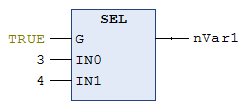SEL
The IEC operator is used for bitwise selection.
Syntax:
OUT := SEL(G, IN0, IN1) means:
OUT := IN0; if G = FALSE
OUT := IN1; if G = TRUE
Permitted data types:
IN0, ..., INn and OUT: Any identical data type. Make sure that variables with the same type are used at all three positions, especially when using user-defined data types. The compiler checks the type equality and issues compilation errors. In particular, the assignment of instances of a function block to interface (variables) is not supported.
G: BOOL
 | TwinCAT does not compute an expression that precedes IN0 if G = TRUE. TwinCAT does not compute an expression that precedes IN1 if G = FALSE. With graphical programming languages, the expressions at IN0 and IN1 are calculated independently of the input G if a function block, a jump, a return, a branch or an edge detection is connected upstream. |
Samples:
ST:
nVar1 := SEL(TRUE,3,4); (*Result: 4*)
FBD:
